

The Google Glass hasn’t even enjoyed its half birthday and it’s already the talk of the tech world. When the first images surfaced of testers wearing the Glass wireframe with its small prism mounted above the right eye, the sleek design brought about the inevitable sci-fi references. Calling up images from Geordi La Forge’s famed VISOR in Star Trek: The Next Generation to Arnold Schwarzenegger’s all-knowing red cyborg eyes in the Terminator movies, Google, it seemed, had taken one giant step towards the robot future so many had predicted.
While many heralded Glass as progress, others raised concerns about privacy and the general social implications. One concerned group launched a campaign to “Stop the Cyborgs,” while elected representatives in West Virginia and elsewhere began touting legislation to regulate the device’s use. As a wheelchair user and a quad, I wasn’t as concerned about all that. All I wanted to know was whether Glass could make navigating our increasingly tech-heavy world easier and improve my quality of life.
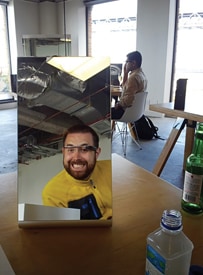
I got in touch with Google, explained my interest and a few weeks later I trekked to one of Google’s Glass “Basecamps” in San Francisco to be fitted for my Glass. For the last month, I’ve been testing it out, talking with other wheelchair-using Glass “explorers” (Google’s term for the early users) and trying to figure out whether Glass fits the wheelchair user’s mobile life like the proverbial slipper, or whether it is just the latest tech craze.
“OK Glass, …”
As my Glass guide, Javier, adjusts the nose pads to fit my face, I’ve got to admit I’m feeling like a cross between Iron Man and the Six Million Dollar Man. I’m looking out over the sun-drenched San Francisco Bay from the fifth floor windows of Basecamp, and all I can think is, “We have the technology!” The Glass comes in a fancy black bag, in a fancy white box with lots of fancy stenciling. The only other things on the table are a sleek mirror and a Google Chrome netbook. After a few seconds of adjusting, Javier leans back, his own Glass staring at me, ready to welcome its newest brother.
“Just tip your head back, then tip it forward,” Javier instructs me. “You should see a clock with the time and ‘OK Glass.’ Say ‘OK Glass,’ then choose what you want to do and say it.”
“OK Glass, take a picture.”
And there it is. With nothing more than an exaggerated nod of the head and a few words I’ve taken my first Glass photo and my first step into the future.
#IFIHADGLASS
If you haven’t seen a Glass explorer in person, it’s because there are only about 10,000 Glasses in the world right now. Unless you are a whiz-kid developer, the only way to get Glass to this point has been to enter a contest where you explain what you would do with Glass using the hashtag #ifihadglass.
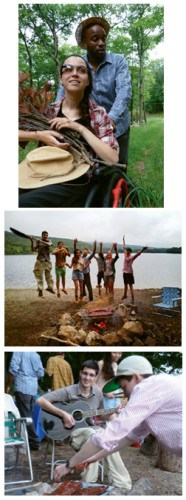
shows how she used Google Glass
while camping with friends.
Among the thousands selected were Alex Blaszczuk and Tammie Van Sant, a pair of quads who were drawn to Glass by the potential of taking pictures and recording video hands-free with Glass’s 5 megapixel camera. The camera can be operated via voice controls, by swiping and tapping the side of the right ear frame or by pressing a tiny button on top of the frame. With their limited dexterity, they had the same issues I did pressing the camera-specific button, but found the voce controls to work superbly.
“The first week I was here in Santa Cruz I think I took a picture of probably everything,” Van Sant said. “After 18 years of not taking pictures, it was amazing.”
For Blaszczuk, the hands-free camera was empowering.
“I was really used to taking pictures before but I had kind of stopped,” she said. “[Now] if I go out with one friend and I’m in the manual wheelchair and someone is pushing me, I have the very important role of taking pictures. That’s been a really positive change.”
Like Blaszczuk and Van Sant, I had an idea of how Glass would help me. The allure of taking photos and videos without having to fumble with my phone and having easy access to Twitter, Facebook and other social media were more than enough to hook me. Yet before I departed Basecamp, one of the Glass developers left me with what would prove to be a prescient thought:
“I honestly believe wearing the device changes what you want to do with it. Until that, you’re bringing the baggage of the notions that you had before of what it might be like, which are more heavily influenced for most people by science fiction than the reality of what it’s going to do.”
More Than Meets the Eye
As I played around with my Glass, I quickly realized what he was talking about. Taking photos and videos and sharing them was great, but what I really found useful was the way Glass freed me from continually having to stop what I was doing to check or use my phone. Van Sant had the same realization.
“For the first period I was just so amazed I was able to take pictures and video,” she said. “I’m now getting into the rest of the things it can do and it’s just amazing … my phone rings and I hear it in the Glass and I just answer the phone. I can chat, send messages and do e-mail — everything just pops up right in front of my face and I can respond without stopping my wheelchair.”
Blaszczuk has also grown to love Glass’s other capabilities.
“The rest of the Glass has been a really positive surprise, not only is it a camera, but you have all of these other functionalities that I‘m also finding useful,” she said.
Third-party software options (referred to as Glassware) are currently limited to mainstays like Facebook, Twitter, Tumblr, The New York Times and CNN, but monthly system updates keep adding more options. Using my Glass to search for other apps being developed, I was inundated with everything from an app to help Jewish users find Kosher restaurants to a facial recognition app that could find and identify people you knew in a crowd (Note: Google has stated it will not approve any facial recognition apps).
I found adding more apps and contacts to be a double-sided affair. On the one hand, the more you add, the better the voice control options are. On the other, the more you add, the longer it takes to manually swipe through and select the options you want using the touch-sensitive side panel.
If you have use of your hands, the side controls offer a powerful and sometimes faster way to access the camera and Glass’s other options. With no use of my fingers, I’ve figured out how to tap and swipe using the side of my knuckle and palm. It works decently, but if you ever see me looking up to the right and swearing under my breath, it’s probably because my blunt gestures were not correctly identified.
Behind the Glass
To understand how Google is working to address these accessibility issues and to help me better understand the vision for Glass, the PR team connected me with Greg Priest-Dorman. Priest-Dorman has been working on Glass for over two years and has been active in the wearable computer world since the 1980s. He showed up for our interview wearing a sleek prototype of Glass that was built into prescription lenses and a worn leather hand brace that looked like Mad Max had built his own version of the old Nintendo Power Glove. The device, which he built in 1998, connects wirelessly with his Glass (or any other device) and has seven keys — one for each finger and three for the thumb — that he uses like a keyboard and mouse.
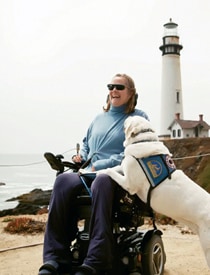
Priest-Dorman got into wearable computers after spending two years in a wheelchair following an incomplete spinal cord injury in his teens. Upon recovering, he found himself only able to work and study when lying down or walking. Not content to lie around, he designed a textbook reader he could wear in a backpack.
He said the Glass team is aware of the current device’s access limitations but sounded optimistic that many of them would be addressed in future iterations.
“Ideally we’re going to take whatever that individual has control over and with their cooperation develop an input system,” he said. “It’s just a matter of looking at what capabilities the person has, or is comfortable with using, and trying to sync that with what the inputs are.”
That could translate to controlling Glass from a touchpad, your phone or something like a communication board. You can also use your phone to view what the heads-up display is showing via a free app available to all users. Reports have already surfaced of developers working on apps to help a wide range of users with disabilities, including muscular dystrophy and Parkinson’s.
Instant Fame
Aside from the potential functional benefits, while wearing Glass I found an unexpected social benefit: Everybody wanted to talk to me. I have never felt so much like a celebrity. From a gas station attendant to a chef to a random passerby, no matter where I went, wide-eyed stares usually led to the ubiquitous, “What is that?”
As a power chair user, I am used to wide-eyed stares and shy or confused people tip-toeing around me. In the last month, thanks to Glass, I have had more strangers initiate conversations with me than I have in the last few years.
“It kind of does take the attention away from my wheelchair because people are looking at my Glass,” said Van Sant. “People aren’t afraid to approach you with it, and they are so stoked to know about it.”
Blaszczuk starred in a short video Google produced to show how Glass might help wheelchair users. She has been heartened by the response of commenters on YouTube.
“There are so many comments where people are like, oh my god right, there are people with disabilities who could benefit from this,” she said.
Clearly, novelty is partially responsible for the public’s fascination, but anything that breaks down some of society’s social inhibitions and gets people talking to wheelchair users seems like a good thing.
The Future
There’s no way to know exactly how many Glass explorers use wheelchairs or deal with mobility impairments, but the Glass team is studying all the feedback they get to better understand how people are using it and what they want from it. The results are far from universal. “We’ve had people who from a label perspective may have what is labeled as the same disability and one person will say, this is amazing I do all this stuff with it and the other person may find it entirely not useful to them,” said Priest-Dorman.
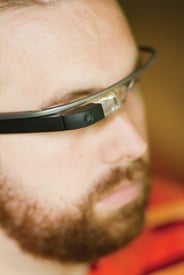
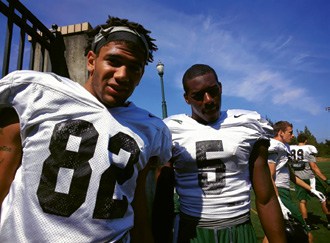 After talking with Blaszczuk and Van Sant, there was little doubt which camp they fell in. “It just amazes me more every day,” said Van Sant. Blaszczuk wished the batteries lasted longer and would have liked more voice commands, but was nearly as enthusiastic as Van Sant. “It’s cool,” she said. “It’s not only cool on a personal utility level, but very cool on an activism-for-people-with-disabilities level.”
After talking with Blaszczuk and Van Sant, there was little doubt which camp they fell in. “It just amazes me more every day,” said Van Sant. Blaszczuk wished the batteries lasted longer and would have liked more voice commands, but was nearly as enthusiastic as Van Sant. “It’s cool,” she said. “It’s not only cool on a personal utility level, but very cool on an activism-for-people-with-disabilities level.”
After just under a month of testing Glass, I mostly agree. Having a high-definition heads-up display is every bit as cool as the movies have made it look. The first time Glass executed my voice commands and the first time a text message popped up while I was rolling through downtown I felt like I had stepped into the future.
As a reporter, being able to take my own pictures at an event and being able to easily record video interviews and share them on the web is empowering. Hands-free access to incoming e-mails and texts allows me to keep moving when I am out and provides that connected feeling that previously required lots of fumbling with my phone. I have had great luck with the voice commands and dictation.
I still haven’t totally adjusted to the idea of wearing a small computer over my right eye, and I’d be lying if I said I was always confident wearing Glass out in public, but I have been impressed by how the design has minimalized the impact on social interactions. That was one of the main design goals, according to Priest-Dorman.
“We wanted to have the device not put barriers between you and other people, but to actually facilitate you being able to be there with them,” he said. “It really is different than a device that you take out to use to focus on or give your attention to, to just have a device that you can count on being there to rely on without being there in the forefront of everything.”
I don’t think there is any doubt that Glass can help improve the lives of wheelchair users. That said, I’m still not sure the Glass slipper is the right fit for me. As a writer and an editor, I work from home. From 9 to 5, I am surrounded by technology that has been customized to my needs. When I am out and about, Glass saves me time and makes it easier to do many things I previously found cumbersome. When I’m at home it feels redundant.
The obvious response is to just wear it when I’m out, and for the most part that is what I have done. But when I’m out, I’m usually with friends or in public places where wearing Glass just doesn’t feel right. I want it to feel right — and it is REALLY close — but it’s not quite there … yet.
The thing to remember, and one of the things members of the Glass team kept reminding me of, is that it is still remarkably early in Glass’s lifespan. “[There are only] a very few people in the percentage of the world population that have Glass,” said Google’s Anna Richardson White. “Imagine when that quadruples or exponentially increases — we’re going to have so many other incredible stories. We’re going to learn about things that Glass can help people do that we have no idea about now.” That may sound a little utopian, but so did Internet-enabled cell phones 20 years ago.
Ian Ruder is editor of NM’s sister publication, Life in Action. Learn more at www.spinalcord.org/life-in-action.
What is Glass?
Glass is the new wearable computer from Google that you wear like a pair of lens-less glasses. Using your voice or simple touch commands, you can access e-mail, get directions, search the Internet, utilize social media and use a growing number of applications. Visual results appear in a small prism mounted in front of your right eye. Images and video look like the equivalent of a 25-inch high definition display if it were 8 feet away. Glass has a 5 megapixel camera that can also be used to record videos. When tethered to your phone, Glass also serves as Bluetooth headset, with audio reproduced through a bone conduction transducer that vibrates in your ear.
Currently, Glass is only available to developers and recipients selected by Google. It costs $1,500, but Google says the price will come down significantly when the product is released to the market sometime in 2014.
Click here to send a letter to the editor to comment on this story.
Support New MobilityWait! Before you wander off to other parts of the internet, please consider supporting New Mobility. For more than three decades, New Mobility has published groundbreaking content for active wheelchair users. We share practical advice from wheelchair users across the country, review life-changing technology and demand equity in healthcare, travel and all facets of life. But none of this is cheap, easy or profitable. Your support helps us give wheelchair users the resources to build a fulfilling life. |


This is such an interesting perspective on the possibilities of Glass. Thanks!
You’re my hero. Thanks for sharing your experience so eloquently.